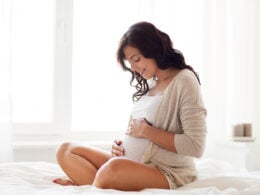Although women have been doing it for centuries, and the practice has some basis in traditional Chinese medicine, it has become a growing trend since the 1970s, particularly in America, for women who just gave birth to consume their placenta [1]. Some have it dehydrated into powder form, put into capsules (called placenta encapsulation), and take it with their daily vitamins. Others freeze it and put raw pieces in a smoothie. Some bake it in lasagna.
If eating your placenta sounds a little gross at first, you’re not alone; but for potentially valuable postpartum relief, take a moment to read on.
Why would women consume their placenta?
This 2018 summary of research noted, “More than 4000 species of mammals consume their placenta; only in humans and camelids [alpacas] has it been noted that the afterbirth is not routinely ingested 7” [2]. Other than the fact that mammals also do this, there is some research to back up the theory that placenta ingestion reduces risk of postpartum mood disorders, decreases length of lochia bleeding, and while it’s still disputed in lactation circles, induces increased and quicker onset of Lactogenesis II (copious milk production).
First, let’s talk about what the placenta even is. It is an entire organ that a pregnant woman produces primarily in the first trimester of a pregnancy in the uterus alongside a growing fetus. (What, you thought you just grew a baby in a pregnancy? Nope, that’s a baby and an entire organ to support it.) The placenta’s primary role is to regulate fetal metabolism, waste removal, respiration, immunological hormone synthesis, and growth.
After delivering a baby, the placenta is then delivered, and the doctor or midwife studies it to be sure it’s all come out. That’s the moment of truth to preserve it, for those hoping to save and consume their placenta. You’ll want to find a trustworthy local source to prepare the placenta for safe consumption, such as placenta encapsulation.
What are the nutritional benefits of placenta encapsulation?
“Placentas contain high amounts of iron and other natural hormones that are needed to maintain good physical and mental health, both prenatally and postpartum,” says Emma Whitlock, a Certified Placenta Encapsulation Specialist in Cleveland, Ohio. “It takes the body about four weeks to build back up the hormones needed for that baseline. Consuming the placenta may help bridge that gap naturally, which may help a new mom avoid synthetic iron or hormones replacement.”
Why is this beneficial? “Natural iron is more bioavailable than what you would get in a supplement,” Whitlock says. “The body may then absorb them and regenerate the levels faster and easier when they come directly from the mother’s body. It is similar to the idea of eating fresh homegrown vegetables from your garden, rather than canned, processed food. The body benefits much better from the natural version over the modified.” In other words, placenta encapsulation is theoretically like a postpartum vitamin that’s tailor-made for each individual woman.
Interestingly, this 2017 randomized, double-blinded study found that placenta encapsulation contained inadequate amounts of iron to meaningfully affect maternal iron levels, and was therefore ineffective at resolving postpartum anemia [3]. And this small 2016 research study found that while placenta samples did not contain toxic amounts of any trace elements, the recommended daily number of capsules provided, for instance, “24% [of the recommended daily allowance or RDA] for iron, 7.1% RDA for selenium, 1.5% RDA for zinc, and 1.4% RDA for copper” [4].
According to this literature review, in addition to high amounts of iron, 450g of placenta contains [1]:
- 234 calories
- 4g of fat
- 899g of cholesterol
- 513g of sodium
- 48g of protein
Typically, women ingest small pieces over the course of two weeks following birth. Some women take it for longer; others, shorter. But usually they are consuming about 3000 mg (or 3 grams) of placenta daily.
Placental tissue also contains significant amounts of trace elements such as copper, calcium, magnesium, potassium, and zinc. There are also essential amino acids like lysine, arginine, tyrosine, and pretty much every type of B vitamin out there. Placental tissue further contains, “hormones such as oxytocin, estrogens, progesterone, adrenocorticotropic hormone (ACTH), Releasing Factor Corticotropin [29], chorionic gonadotropin, hypothalamic releasing hormones (GnRH), placental lactogen, placental opioid enhancing factor (POEF), relaxin, and inhibin [30,31]” [1]. But just how much of each of these hormones is actually absorbed by the mother is unknown [1].
Does eating your placenta make a difference?
With that being said, women in industrialized nations likely have access to a full, varied, selection of food, and have often been taking prenatal vitamins throughout their pregnancy so the boost of placental supplements isn’t doing as much for them as the primate in the wild Sahara.
After giving birth, there is a massive hormone withdrawal. This is primarily due to the expulsion of the placenta which contains high levels of both estrogen and progesterone—but relatively higher levels of progesterone. Estrogen (responsible for the first half of the menstrual cycle) increases energy levels. Progesterone (responsible for the latter half of our menstrual cycles) is a mood stabilizer, sleep promoter, and puts brain and blood cells in “repair mode.” These high levels of hormones are likely responsible for women’s accounts of mood stabilization and energy boosts after consuming their placenta [5]. Full disclosure, though: hormone concentrations from placenta to placenta vary wildly, affected mostly by stress, mode of delivery, and dietary intake during pregnancy [2].
For women who do placenta encapsulation, there have been reports of quicker and more plentiful induced lactation due to Human Placental Lactogen, a hormone found in the placenta. It could also simply be related to the consumption of high levels of protein and fat—necessary dietary components for proper lactation.
In lactation circles, the consensus is split whether or not practitioners support placental consumption. While there is evidence for induced lactation there are many cases of quite the opposite. This is likely due to the high levels of estrogen and progesterone, which often contend with prolactin, the key hormone responsible for lactation. In some cases, the placenta is beneficial for bringing on milk, but not so helpful in maintaining an adequate milk supply.
As the 2018 summary of research “There has been little systematic investigation into the associated benefit and potential risks, however. Obstetricians and pediatricians are faced with an increasing demand from patients, but general recommendations on placentophagy [consumption of the placenta released during childbirth] founded upon scientific data have yet to be produced” [2].
But like everything health related, everyone has different reactions, so it is the individual who can best make decisions about their care. If a mother is struggling to maintain a supply, she can simply stop ingesting placenta and she will know within a few days if it was the culprit. In most cases, placental consumption is considered a lactation inducer.
What to watch out for when eating your placenta
While there are benefits to consuming placenta, there are also some risks and contraindications worth considering. While there are crucial trace elements in the placenta like magnesium and calcium, there is also a slight risk of very low concentrations of potentially toxic elements like arsenic, lead, and mercury. If these elements are present, they are usually below the toxicity threshold.
It is also possible that the placenta contains microorganisms that can cause disease. Placental tissue is not sterile, so contamination can not be completely ruled out. Dehydrating the tissue significantly reduces this risk, but this also can reduce the quality of the placental hormones, vitamins, and minerals. If a general anesthetic was used during the labor and birth, it is possible that the drug was also transported to the placental tissue, so discretion should be used in that instance [1]. And in mothers who smoke, there is a possibility of cadmium buildup which could be dangerous to the baby.
Lastly the contraindications for placental consumption are Group B Strep-positive mothers, mothers with transmissible infections of any kind such as HIV/AIDS, as well as mothers with pregnancy or postpartum-related infections like mastitis, where a clogged duct has become infected [6]. A 2017 case study from the Centers for Disease Control and Prevention (CDC) described a case of an infant who developed late-onset Group B strep (GBS) infection requiring hospitalization after the mother consumed GBS-infected placental capsules, though the 2018 research summary observed “In case of maternal, oral ingestion it is assumed that the stomach functions as a barrier against bacteria, including streptococci. The maternal intake of placenta as a route for infection is therefore debatable” [6][2].
If you are pregnant, talk to your midwife or OB about placenta consumption. (If anything, they need to know for after the birth whether or not to toss the placenta!) Weigh your risks and benefits with your doctor.
References
[1] Mota-Rojas D, Orihuela A, Strappini A, Villanueva-García D, Napolitano F, Mora-Medina P, Barrios-García HB, Herrera Y, Lavalle E, Martínez-Burnes J. Consumption of Maternal Placenta in Humans and Nonhuman Mammals: Beneficial and Adverse Effects. Animals. 2020; 10(12):2398. https://doi.org/10.3390/ani10122398[2] Johnson, Sophia K. et al. “Placenta – Worth Trying? Human Maternal Placentophagy: Possible Benefits and Potential Risks.” Geburtshilfe und Frauenheilkunde: 14 September 2018.
[3] Gryder, Laura K et al. “Effects of Human Maternal Placentophagy on Maternal Postpartum Iron Status: A Randomized, Double-Blind, Placebo-Controlled Pilot Study.” Journal of midwifery & women’s health vol. 62,1 (2017): 68-79. doi:10.1111/jmwh.12549 [4] Young, Sharon M et al. “Human placenta processed for encapsulation contains modest concentrations of 14 trace minerals and elements.” Nutrition Research, vol. 36, iss. 8 (2016): pp. 872-78. ISSN 0271-5317, https://doi.org/10.1016/j.nutres.2016.04.005. [5] Selander, Jodi et al. “Human maternal placentophagy: a survey of self-reported motivations and experiences associated with placenta consumption.” Ecology of food and nutrition vol. 52,2 (2013): 93-115. doi:10.1080/03670244.2012.719356 [6] Buser GL, et al. “Notes from the Field: Late-Onset Infant Group B Streptococcus Infection Associated with Maternal Consumption of Capsules Containing Dehydrated Placenta.” Morbidity and Mortality Weekly Report: 2016.










